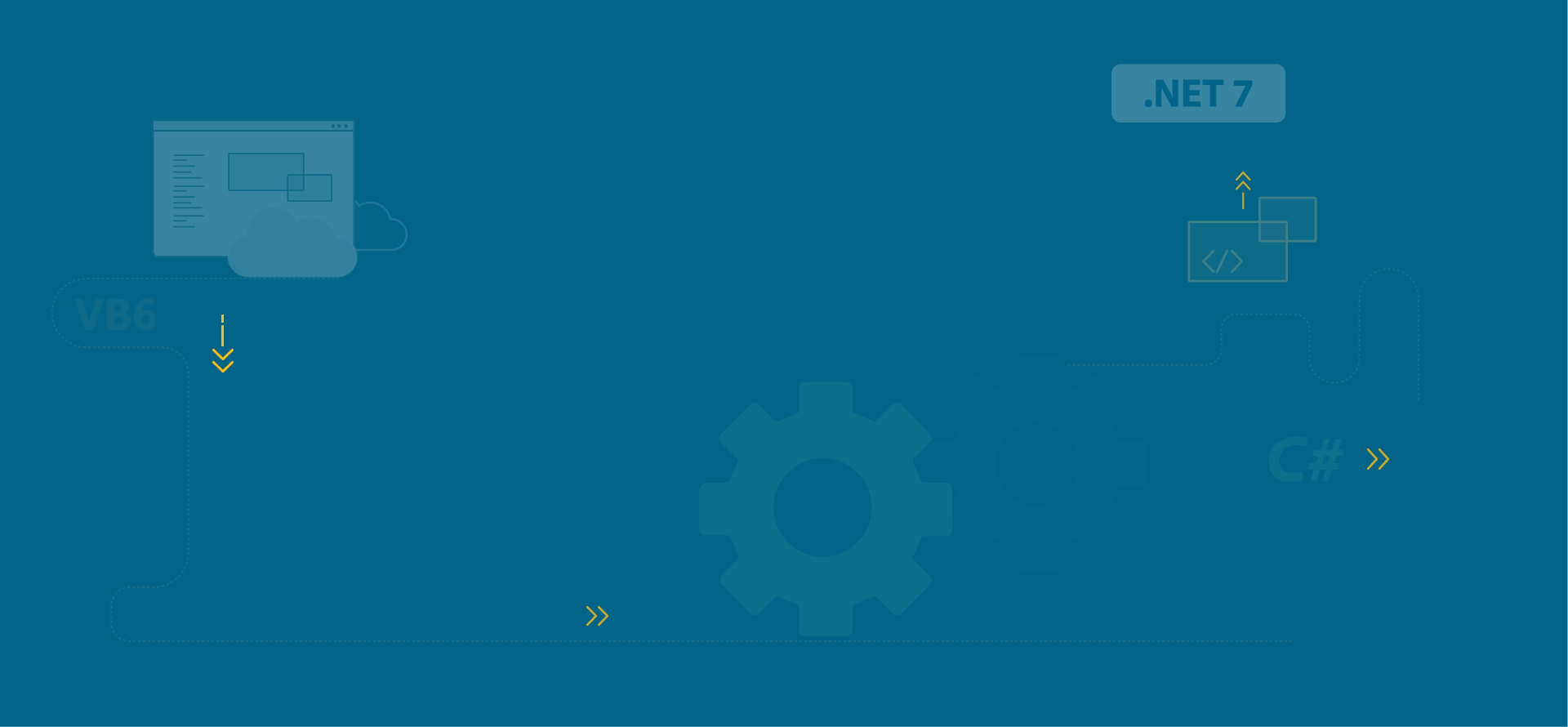
Modernize your desktop application by migrating to Blazor for a scalable, cloud-based future with .NET.
If you've built applications using C#, you've already harnessed the power and flexibility of the language. But the digital landscape is shifting. Users now demand web-based access to applications, from any device, anywhere. It's time to bring your desktop C# applications into the modern era with Blazor.
WebMAP is the bridge that brings your powerful C# apps to the web. It's more than a migration tool - it's a catalyst for innovation. Uncover new possibilities for your applications, expand your reach and delight your users with modern, interactive web experiences.
That's where WebMAP for Blazor comes in. Here's how it simplifies the process:
.png?width=1518&height=964&name=byteinsight%20(1).png)
Our Free Code Assessment Tool provides a comprehensive analysis of your existing codebase, giving you valuable insights before starting your migration journey. It scans your application to accurately count effective lines of code, identify dependencies, and assess the technologies in use. With detailed reports, you'll gain a clearer understanding of your application's structure, making it easier to plan a smoother, more efficient migration.
This structured approach delivers a seamless migration with minimal disruption, unlocking the power of Angular for your business.

Blazor is a powerful and versatile web framework developed by Microsoft that enables developers to build modern web applications using C# instead of JavaScript. Here are some of its core concepts and benefits:
Core Concepts:
Benefits:
In essence, Blazor offers a modern and efficient approach to web development, combining the power and familiarity of .NET with the performance and flexibility of modern web technologies.
Blazor is a strong contender in the web development landscape, offering unique advantages alongside established frameworks like Angular and React. Here's a comparative overview:
Performance:
Developer Experience:
Community Support:
Key Considerations:
Ultimately, the best choice depends on your specific project needs, team expertise, and desired development experience. We've seen many clients successfully transition from Angular/React to Blazor due to increased developer productivity and a more streamlined workflow.
Our solution uses Blazor Server for faster initial load times and to support projects with existing codebases that may not have a clear separation of concerns. While migrating components to Blazor WebAssembly is possible post-migration, it's not our default approach.
WebMAP for Blazor supports most common components. We'll review your application with our code analysis tools to verify compatibility. Our migration tool is constantly being improved with new features added regularly so we will be able to continue to improve your app.
To access hardware devices, you can use IoT mechanisms that expose them via a web service accessible to your application. Alternatives include using a local agent or browser-specific features. The optimal approach depends on the hardware type and whether access is needed per device or centrally.
While the converted Blazor application won't be fully responsive by default, it retains the look and feel of your existing application to minimize user retraining. This approach prioritizes a seamless transition for your users.
However, because the conversion uses standard web components, achieving responsiveness is entirely possible. We can work with you to progressively enhance the UI, focusing on frequently used screens or specific elements that would benefit most from responsive design. This allows you to prioritize responsiveness where it matters most while retaining the familiar structure for less critical areas.
WebMAP for Blazor generates a UI that closely resembles the original application by combining standard Blazor controls with custom-built Blazor elements for complex controls.
The tool intelligently translates your desktop application's UI into a Blazor-based web interface. Here's how:
This process results in a Blazor application that closely resembles your original desktop application, minimizing user disruption while providing the benefits of a modern web application.
Yes, the converted Blazor application can be scaled to accommodate a large number of concurrent users and handle increased traffic loads. Here's how:
Capacity Planning:
While Blazor Server can handle hundreds of users per server, the exact capacity depends on factors like server resources and application complexity. We'll work with you to assess your specific needs and ensure the infrastructure can handle your expected user load.
Scaling Beyond Hundreds of Users:
For applications requiring massive scalability (thousands or more concurrent users), we can explore alternative architectures or hybrid approaches that combine Blazor Server with other technologies.
By leveraging the scalability of Blazor Server and implementing appropriate optimization strategies, we can ensure your converted application can handle substantial user growth and traffic demands.
The converted Blazor application offers a wide range of deployment options, providing flexibility to meet your specific infrastructure needs and preferences:
Cloud Platforms:
On-Premise:
Hybrid Environments:
We'll collaborate with you to assess your requirements and recommend the most suitable deployment strategy for your converted Blazor application, ensuring optimal performance, scalability, and security.
While the automated migration process itself won't convert your application to a multi-tenant architecture, Blazor provides excellent support for multi-tenancy, and we can help you implement it effectively.
Here's a breakdown of the key considerations and approaches:
Database Strategy:
Application Logic:
Deployment and Configuration:
Post-Migration Refactoring:
After the initial migration, we can collaborate with you to refactor the application and implement the chosen multi-tenant architecture. This might involve:
By leveraging Blazor's capabilities and implementing a well-defined multi-tenant strategy, we can help you create a scalable and secure application that serves multiple customers effectively from a single instance.
The conversion process preserves your existing authentication and authorization logic, ensuring a seamless transition for your users. However, migrating to Blazor opens up a world of possibilities for enhancing security and access control. Here's how:
Preserving Existing Mechanisms:
Enhancements and New Possibilities:
GAP's Expertise:
We can guide you through the process of evaluating your security needs and implementing the most suitable authentication and authorization solutions for your converted Blazor application. This includes:
By combining the preservation of your existing security measures with the flexibility and power of Blazor's security framework, we can ensure your converted application is both secure and user-friendly.
Our AI-assisted cloud application migration tools cut project workload by 4X. Tamper-free business logic migration reduces overall defect risk. Optional fixed-price projects eliminate financial risk.
Code you’ll understand, built with C#, HTML, ASP.NET Core, and more. No magic runtimes, no long-term costs like with virtualization. You get new code you can use.

Modernize your C# WinForms application by migrating to Blazor
Learn More →
Modernize your VB6 application by migrating to Blazor
Learn More →
Transformative PowerBuilder to C# / Blazor migration tools
Learn More →
Modernize your VB.NET WinForms application by migrating to Blazor
Learn More →
Go cloud native with your Blazor web migration
Learn More →
View all products and migration offerings
Learn More →

Mobilize.Net offers valuable technology and services that help customers easily modernize their legacy applications for use on today’s modern platforms and devices program at Microsoft.
- Shawn Nandi, Sr Director, Cloud App Development, Data & AI Marketing
We were able to migrate our VB6 code to .NET using the VBUC license we acquired through MSDN. After the migration only a few things needed manual modification. So your software did a great job and saved us a lot of time
- JMarco Botermans, Owner - Fluke
“Mobilize.Net has a strong track record of building products that successfully automate challenging source code migrations, and this [product] will empower our customers to get up and running on Snowflake sooner.”
- Chris Degnan, CRO at Snowflake
Mobilize.Net seemed the only one that sorted out the details, not only the basic issues of a migration engagement. Its product, the Visual Basic Upgrade Companion, included unique, powerful features, many of which turned out to be very valuable for this specific project, like ADO to ADO.NET conversion and error handling transformation
- Rod Coles – President, Bold Technologies, Ltd
We ran a proof of concept comparing the Visual Basic Upgrade Companion (VBUC) with other VB6 migration tools and we definitely preferred the way VBUC handled the conversion.
- James Lewis Stevenson II – Software Design Engineer, GT Software





8834 N Capital of Texas Hwy, Ste 302
Austin, TX 78759
Call us: +1.512.243.5754
info@wearegap.com